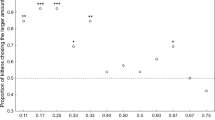Abstract
The reaction to a new food and the initiation of its consumption were studied in daily sessions in 19 weanling kittens from four litters at 30–39 days of age. The new food consisted of canned tuna for two litters and cereal (cooked cream of wheat with 3% addition of vegetable oil and broth flavor) for the other two litters. Each litter was divided into two groups. One group was offered the new food in the presence of the mother which had been consuming it (eating cereal had to be induced in the mothers by the hypothalamic stimulation reward method). Another group of kittens received the same food in the absence of the mother. It was found that the kittens which had been offered the new food in the presence of the mother showed only a short-lasting orienting reaction and started to eat the new food on the first or second day (with a mean delay of 0.2 days). On the other hand, the kittens which had been offered the new food in the absence of the mother showed a strong orienting reaction and started to eat the new food only after several daily sessions (with a mean delay of 4.8 days). No significant difference was found between the number of days of delay in eating by kittens offered tuna and by kittens offered cereal in the absence of the mother. The initiation of consumption of the new food by these kittens was preceded by a period of playing with the plate on which the food had been placed. Additional observations showed that the fourto five-month old kittens that had eaten cereal during early training preferred that food over meat pellets; the other kittens of the same age that had eaten tuna, but no cereal, during early training refused to eat cereal when it was offered to them when they were hungry.
Similar content being viewed by others
References
Booth, D. A., Stoloff, R. and Nicholls, J.: Dietary flavor acceptance in infant rats established by association with effects of nutrient composition.Physiological Psychology 2(3A), 313–310, 1974.
Burghardt, G. M. and Hess, E. H.: Food imprinting in the snapping turtle,Chelydra serpentina.Science 151, 108–109, 1966.
Capretta, P. J.: The establishment of food preferences in chicks,Gallus gallus. Animal Behavior 17, 229–231, 1969.
Capretta, P. J. and Rawls, L. H.: III. Establishment of a flavor preference in rats: Importance of nursing and weaning experience.Journal of Comparative and Physiological Psychology 86, 670–673, 1974.
Galef B. G. and Clark M. M.: Social factors in the poison avoidance and feeding behavior of wild and domesticated rat pups.Journal of Comparative and Physiological Psychology 75, 341–357, 1971.
Galef, B. G. and Clark, M. M.: Mother’s milk and adult presence: two factors determining initial dietary selection by weanling rat pups.Journal of Comparative and Physiological Psychology 78, 220–225, 1972.
Gantt, H. W.:Experimental Basis for Neurotic Behavior. New York, Hoeber, 1944.
Hall, W. G.: Feeding and behavioral activation in infant rats.Science 205, 206–209, 1979.
Hess, E. H.: Imprinting and the “critical period” concept.In E. L. Bliss, (ed.):Roots of Behavior. New York, Harper & Row, 1962, pp. 254–267.
Hogan, J. A.: How young chicks learn to recognize food.In R. A. Hinde and J. Stevenson-Hinde (ed.):Constraints on Learning. London, Academic Press, 1973, pp. 119–139.
Rabinowitch, V. E.: The role of experience in the development and retention of seed preferences in zebra finches.Behavior 33, 222–236, 1969.
Reisbick, S. H.: Development of food preferences in newborn guinea pigs.Journal of Comparative and Physiological Psychology 85, 427–442, 1973.
Shreck, P. K., Sterritt, G. M., Smith, M. P. and Stilson, D. W.: Environmental factors in the development of eating in chicks.Animal Behavior 11, 306–309, 1963.
Turner, E. R. A.: Social feeding in birds.Behavior 24, 1–46, 1964.
Woodruff, G. and Starr, M. D.: Autoshaping of initial feeding and drinking reactions in newly hatched chicks.Animal Learning Behavior 6, 265–272, 1978.
Wortis, R. P.: The transition from dependent to independent feeding in the young ring dove. Part 1.Animal Behavior Monographs 2, 3–53, 1969.
Wyrwicka, W.: Imitation of mother’s inappropriate food preference in weanling kittens.Pavlovian Journal of Biological Science 13, 55–72, 1978.
Wyrwicka, W.: Imitation of mother by weanling kittens in eating odorless and tasteless jellied agar.Federation Proceedings 38, 1309, 1979.
Author information
Authors and Affiliations
Additional information
Supported by USPHS grant No. MH13958 and a grant from the Weight Watchers Foundation.
Rights and permissions
About this article
Cite this article
Wyrwicka, W., Long, A.M. Observations on the initiation of eating of new food by weanling kittens. Pav. J. Biol. Sci. 15, 115–122 (1980). https://doi.org/10.1007/BF03003692
Issue Date:
DOI: https://doi.org/10.1007/BF03003692




